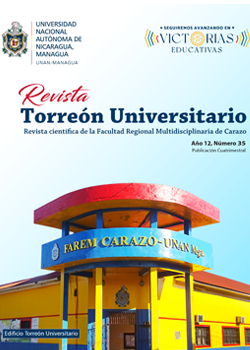Tourist perception of the inhabitants surrounding the nature reserves dedicated to tourism
DOI:
https://doi.org/10.5377/rtu.v12i35.16999Keywords:
Community, Perception, Natural Reserves, Tourism, Latin AmericaAbstract
The main objective of this study is to determine the perception of the inhabitants about tourism in Nature Reserves. This research was initially field based because a survey was applied to the students of Tourism and Hotel Administration of the UNAN FAREM Chontales and then it became documentary by collecting information from previous research to determine the perception of the following Latin American countries: Peru, Argentina, Dominican Republic, Ecuador and Uruguay in a period of 2015-2020. To make the comparison, three factors were taken into consideration: economic: income and economic development; sociocultural: cultural preservation and quality of life; environmental: environmental preservation and pollution. Regarding the results obtained from the collection of data from the inhabitants of various communities in Latin America, these reflect a total of 2,594 in which 83.11% of the population has a positive perception of the economic factor: income and 76.79% on the economic development, according to the sociocultural factor, 63.3% perceive cultural preservation and 80.53% consider that it improves the quality of life. Finally, with the environmental factor, 74.5% perceive preservation of the environment and 25% consider that pollution increases.
Downloads
References
Alfonzo, I. (1994). Técnicas de investigación bibliográfica. Caracas: Contexto Ediciones.
Altamira, R. (2007). Turismo como motor de crecimiento económico. Anuario Jurídico y Económico Escurialense.
Aragón, R. (2018). Percepciones de gestión del turismo sostenible: estudio comparativo en dos comunidades aledañas a reservas nacionales (Tambopata Y Titicaca), Perú. Lima, Perú.
Bialostozky, C. J. (2010). Conceptos y definiciones en relación con el empleo el desempleo y el subempleo. México: Dirección General de Estadística.
Blasco, M. R. (2017). Un análisis de los factores socioculturales en el emprendimiento. Cartagena: Universidad Politécnica de Cartagena.
Bonilla, E., & Rodríguez, P. (1997). Mas allá del dilema de los métodos. Santa fe de Bogotá: Uniandes.
Cañero, P. (2018). Impactos del turismo comunitario y sostenibilidad en comunidades rurales de Puerto Plata (República Dominicana). Un análisis de la percepción de los residentes. Córdoba.
Cruz, A. (2021). Percepción de los estudiantes de Administración turística y hotelera sobre el turismo en la Serranía de Amerrique. Juigalpa: UNAN- Managua.
Fernández, J. (2009). Percepción Social del turismo. España: Universidad de las Islas Baleares.
Go Ecuador. (s,f). Centro de Turismo Comunitario Shiripuno [fotografía] GoEcuador. https://goecuador.net/guia-de-turismo/Centro-de-Turismo-Comunitario-Shiripuno-travel-ecuador
Hernández, J. (2017). Calidad de Vida, Inclusión Social y Bienestar Humano. UNERMB
JOFRE, M. A. (1989). Concepto de cultura. Santiago: CENECA.
La Región. (2020). Pehuen Co [fotografía]. La voz del pueblo. https://lavozdelpueblo.com.ar/noticia/102556-Pehuen-Co:-aventura,-naturaleza-y-ciencia-en-un-mismo-lugar
MapiTravel, (2021). Reserva Nacional de Tambopata [fotografía]. Machupichu. https://www.machupicchu.biz/reserva-nacional-de-tambopata
Pérez, E (2021). Salto del indio [Fotografía]. Artelista. https://www.artelista.com/en/artwork/5989613066749288-saltodelindio.html
Ponce, C (2017). Puerto Plata – República Dominicana [fotografía]. Diosa Si Blog de viajes. http://diosasi.blogspot.com/2017/09/el-parque-nacional-isabel-de-torres-el.html
Rojas, V. (2020). Percepciones de la población residente sobre los impactos turísticos en el desarrollo local. Estudio de caso: departamento de Maldonado, Uruguay. Aigua.
Smurra, F. (2019). La percepción de los residentes respecto a los impactos del turismo. Estudio de caso: Pehuen Có. Bahia Blanca.
Vargas, L. (1994). Sobre el concepto de percepción. México DF: Universidad Autónoma Metropolitana Unidad Iztapalapa.
Vargas, M. [Kem Vargas]. (2021, 3 de febrero). [post]. Facebook: Recuperado el 5 de julio de 2021,..de https://www.facebook.com/photo?fbid=4061595910519637&set=pb.100000078059546.-2207520000.
Published
How to Cite
Issue
Section
License
Copyright (c) 2023 National Autonomous University of Nicaragua, Managua

This work is licensed under a Creative Commons Attribution-NonCommercial-NoDerivatives 4.0 International License.
The authors who publish in this journal agree to the following terms.
- The author or authors of the articles, essays or research grant the National Autonomous University of Nicaragua, Managua (UNAN-Managua) the editing rights (copyright) of the submitted work, therefore the University has the exclusive right to publish the article for the entire copyright period.
- These copyrights/authors authorize Torreón Universitario Magazine and the University to edit and disseminate/publish the article in said Magazine, including printed and electronic reproduction, storage, retrieval and any other type of publication, and sources of secondary information as services. of summaries and databases, they also empower it to protect the article against unauthorized use for dissemination by printed or electronic media (PDF, HTML, EPUB, XML or others).
License for use of content
The magazine uses the Creative Commons Attribution-NonCommercial-NoDerivs 4.0 International License.
Under this statement:

This journal is licensed under a Creative Commons Attribution-NonCommercial-NoDerivatives 4.0 International License. It can be copied, distributed and transmitted publicly as long as the author and source are cited (Revista Torreón Universitario), it should not be modified or used for any commercial purpose. The full license can be found at http://creativecommons.org/licenses/by-nc-nd/4.0/.



